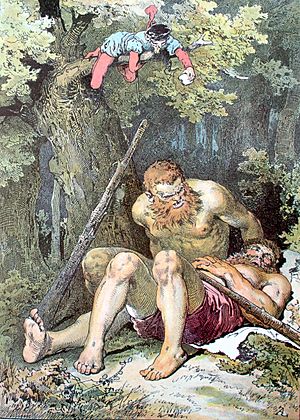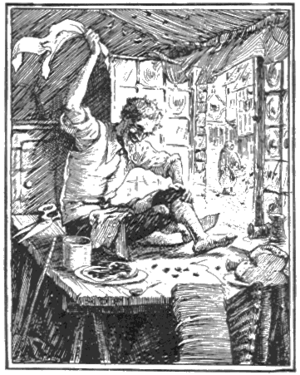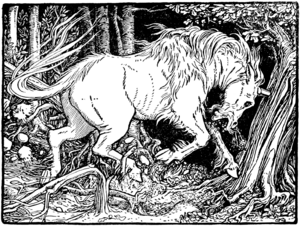The Brave Little Tailor facts for kids
Quick facts for kids The Brave Little Tailor |
|
|---|---|

|
|
| Folk tale | |
| Name | The Brave Little Tailor |
| Also known as | The Valiant Little Tailor |
| Data | |
| Aarne–Thompson grouping | ATU 1640 (The Brave Tailor) |
| Country | Germany |
| Published in | Grimm's Fairy Tales |
| Related | "Jack and the Beanstalk", "Jack the Giant Killer", "The Boy Who Had an Eating Match with a Troll" |
"The Brave Little Tailor" is a famous German fairy tale collected by the Brothers Grimm. It is also known as "The Valiant Little Tailor." This story is about a clever tailor who uses his wits, not his strength, to trick powerful giants and a king. His smart plans help him gain wealth and power.
Story Origin
The Brothers Grimm first shared this tale in their book Kinder- und Hausmärchen in 1812. They gathered the story from different spoken and written sources of their time.
Story Summary

A tailor is about to enjoy some jam. But flies land on it, so he quickly swats them. He kills seven flies with just one blow! Proud of his deed, he makes a belt that says "Seven at One Blow." He then decides to leave home and seek his fortune in the world.
On his journey, the tailor meets a huge giant. The giant sees the belt and thinks "Seven at One Blow" means seven men, not flies. The giant challenges the tailor to a test of strength. First, the giant squeezes water from a hard rock. The tailor, being clever, squeezes what looks like milk from a piece of cheese. The giant is amazed.
Next, the giant throws a rock high into the air. It flies far away and eventually lands. The tailor then throws a small bird into the sky. The bird flies so high that it disappears. The giant believes this tiny bird is a "rock" thrown so far it never comes down.
Later, the giant asks the tailor to help him carry a large tree. The tailor tells the giant to carry the heavy trunk. He says he will carry the branches. But instead, the tailor secretly climbs onto the branches. So, the giant ends up carrying both the tree and the tailor! It looks like the tailor is holding up the branches all by himself.
The giant is very impressed and takes the tailor to his home, where other giants live. That night, the giant tries to kill the tailor by smashing his bed. But the tailor, finding the bed too big, had moved to sleep in a corner. When the giant returns and sees the tailor alive, all the giants get scared. They quickly run away from the small, brave man.
The tailor then joins the king's army. But the other soldiers are worried. They fear that if the tailor gets angry, he might kill seven of them with one blow. They tell the king that either the tailor leaves, or they will. The king is afraid to send the tailor away, fearing the tailor might harm him.
So, the king tries to get rid of the tailor in another way. He sends him to defeat two more giants, along with a hundred horsemen. The king promises the tailor half his kingdom and his daughter's hand in marriage if he succeeds. The tailor finds the two giants sleeping. He throws rocks at them, making them think the other giant is attacking. They start fighting each other until they both die. The tailor then stabs them to make sure they are truly defeated.

The king is surprised the tailor won. He doesn't want to keep his promise. So, he gives the tailor two more impossible tasks. First, he sends him to capture a unicorn. The tailor stands in front of a tree. When the unicorn charges, he quickly steps aside. The unicorn's horn gets stuck deep in the tree trunk.
Next, the king sends him to catch a wild boar. The tailor uses a similar trick. He lures the boar into a chapel. Once inside, he quickly locks the door, trapping the boar.
The king is finally truly impressed. He keeps his promise and lets the tailor marry the princess. The tailor becomes the ruler of half the kingdom. One night, the tailor's new wife hears him talking in his sleep. She realizes he was just a tailor, not a noble hero. She gets very angry.
The princess demands that the king have the tailor killed or sent away. A squire warns the tailor about the king's plan. When the king's servants come to the door, the tailor pretends to be talking in his sleep. He says, "Boy, make the jacket for me, and patch the trousers! Or I will hit you with a yardstick! I have struck down seven with one blow, killed two giants, led away a unicorn, and captured a wild boar. Why should I be afraid of those standing outside the bedroom?"
The king's servants hear this and are terrified. They quickly leave. The king never tries to harm the tailor again. So, the brave little tailor lives out his days as a king.
Similar Stories
Many other stories around the world are like "The Brave Little Tailor." These tales often feature a clever hero who uses smart tricks instead of brute strength to overcome big challenges. For example, similar stories have been found in Spain, Denmark, England, Ireland, Hungary, and even in parts of Asia like Turkey, India, and Sri Lanka.
Story Adaptations
This popular fairy tale has been made into many different forms:
- Mickey Mouse starred in a 1938 Disney cartoon called Brave Little Tailor, based on this story.
- A music piece called L'histoire du petit tailleur was created in 1950. It features a narrator and instruments.
- The story was an episode in the 1987–1989 anime TV series Grimm's Fairy Tale Classics.
- Happily Ever After: Fairy Tales for Every Child, an HBO animated TV series (1995–2000), featured "The Valiant Little Tailor." In this version, the story was set in West Africa.
- A French novel, Le vaillant petit tailleur, retold the fairy tale in 2004.
- A short story called "Satmaar Palowan" ("The Wrestler Who Kills Seven") by Bengali writer Upendrakishore Ray Chowdhury was inspired by this tale.
- A Soviet cartoon based on the fairy tale was made in 1964.
- In the video game Fairy Tale Fights, the Brave Little Tailor is a main character. He tries to steal fame from other fairy tale heroes.
|
See also
 In Spanish: El sastrecillo valiente para niños
In Spanish: El sastrecillo valiente para niños

